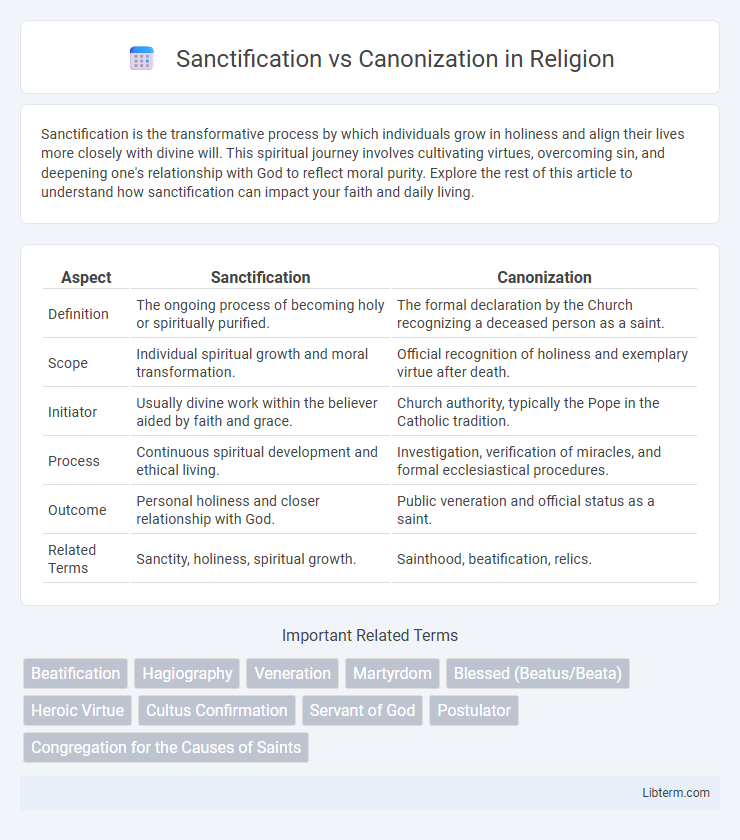Sanctification is the transformative process by which individuals grow in holiness and align their lives more closely with divine will. This spiritual journey involves cultivating virtues, overcoming sin, and deepening one's relationship with God to reflect moral purity. Explore the rest of this article to understand how sanctification can impact your faith and daily living.
Table of Comparison
| Aspect | Sanctification | Canonization |
|---|---|---|
| Definition | The ongoing process of becoming holy or spiritually purified. | The formal declaration by the Church recognizing a deceased person as a saint. |
| Scope | Individual spiritual growth and moral transformation. | Official recognition of holiness and exemplary virtue after death. |
| Initiator | Usually divine work within the believer aided by faith and grace. | Church authority, typically the Pope in the Catholic tradition. |
| Process | Continuous spiritual development and ethical living. | Investigation, verification of miracles, and formal ecclesiastical procedures. |
| Outcome | Personal holiness and closer relationship with God. | Public veneration and official status as a saint. |
| Related Terms | Sanctity, holiness, spiritual growth. | Sainthood, beatification, relics. |
Introduction to Sanctification and Canonization
Sanctification refers to the spiritual process by which a person becomes holy through the influence of the Holy Spirit, characterized by growth in grace and moral purity. Canonization is the formal declaration by the Catholic Church, recognizing a deceased person as a saint based on evidence of miracles and virtuous life. Both processes highlight different aspects of holiness, with sanctification emphasizing personal spiritual transformation and canonization focusing on official ecclesiastical recognition.
Defining Sanctification: Spiritual Growth Explained
Sanctification is the ongoing spiritual process through which believers are progressively transformed to reflect the holiness and character of God, emphasizing moral growth and divine grace in everyday life. It involves the work of the Holy Spirit in shaping a person's heart, mind, and actions toward Christlikeness, distinct from the formal recognition given by canonization. Spiritual growth in sanctification includes developing virtues such as love, patience, and humility, marking an internal transformation that deepens one's faith and commitment.
Understanding Canonization: Official Church Recognition
Canonization is the official process by which the Catholic Church formally recognizes a deceased person as a saint, confirming their exemplary holiness and granting them universal veneration. This process involves rigorous investigation of the individual's life, virtues, and miracles attributed to their intercession, typically requiring verification of at least two miracles. Canonization is a definitive act that affirms the person's place in the Church's liturgical calendar and allows public devotion, distinguishing it from sanctification, which refers more broadly to the personal growth in holiness.
Historical Origins of Sanctification and Canonization
Sanctification traces back to early Christian practices emphasizing personal holiness and spiritual purification, deeply rooted in biblical teachings and Church tradition. Canonization emerged in the Middle Ages as a formalized papal process to officially recognize saints, evolving from localized veneration to centralized ecclesiastical authority. Both concepts reflect the Church's development in defining and honoring sacred individuals, with sanctification focusing on spiritual transformation and canonization on official ecclesiastical recognition.
Theological Foundations: Key Differences
Sanctification involves the ongoing spiritual process of becoming holy through God's grace, reflecting a believer's internal transformation and moral growth. Canonization, by contrast, is an official ecclesiastical declaration recognizing a deceased person as a saint, signifying that their life exemplified heroic virtue and they are worthy of public veneration. Theologically, sanctification pertains to personal sanctity and divine cooperation in spiritual maturation, while canonization serves as a formal recognition of sanctity, affirming a model of holiness for the faith community.
Sanctification in Different Christian Traditions
Sanctification in Christian traditions varies significantly, with Protestant theology often emphasizing the ongoing process of spiritual growth and moral transformation through the Holy Spirit, while Eastern Orthodox Christianity views sanctification as theosis, a mystical union with God. Roman Catholicism integrates sanctification with the sacraments, particularly the Eucharist and Confession, as means of grace that progressively cleanse and sanctify the soul. These diverse perspectives highlight sanctification as both a personal and communal journey toward holiness within different theological frameworks.
The Canonization Process: Steps and Criteria
The canonization process in the Catholic Church involves a rigorous investigation of a candidate's life, virtues, and miracles attributed to their intercession, typically requiring two verified miracles for sainthood. The primary steps include a local diocesan inquiry, examination by the Congregation for the Causes of Saints, declaration of heroic virtue, beatification, and finally canonization. Criteria focus on evidence of a holy life, unwavering faith, and confirmed miraculous events posthumously recognized by the Vatican.
Role of Miracles in Canonization Compared to Sanctification
Miracles play a crucial role in the canonization process as concrete evidence of a candidate's divine intercession, typically requiring verified miracles both before and after death to confirm sainthood. In contrast, sanctification emphasizes the ongoing spiritual growth and holiness in the believer's life, where miracles are not a necessary criterion but may occur as signs of grace. Canonization involves rigorous investigation and authenticated miracles, while sanctification is a personal or communal journey toward holiness without formal miraculous validation.
Contemporary Perspectives: Modern Views and Debates
Contemporary perspectives on sanctification emphasize its ongoing spiritual process within an individual's life, highlighting personal transformation through grace and faith in Christian theology. Canonization, by contrast, remains a formal ecclesiastical declaration recognizing a person's sainthood, with modern debates questioning the criteria and cultural relevance in a globalized, pluralistic Church. Scholars and theologians analyze how these concepts intersect, focusing on the tension between universal recognition of holiness and individualized spiritual growth.
Conclusion: Impact on Faith and Religious Practice
Sanctification deepens personal holiness and spiritual growth, fostering a continuous transformation in the believer's life aligned with divine will. Canonization, as the formal recognition of sainthood by the Church, provides a model of exemplary faith and virtue for communal veneration and inspiration. Both processes significantly influence religious practice by shaping individual piety and reinforcing communal identity through the celebration of recognized holy figures.
Sanctification Infographic

 libterm.com
libterm.com